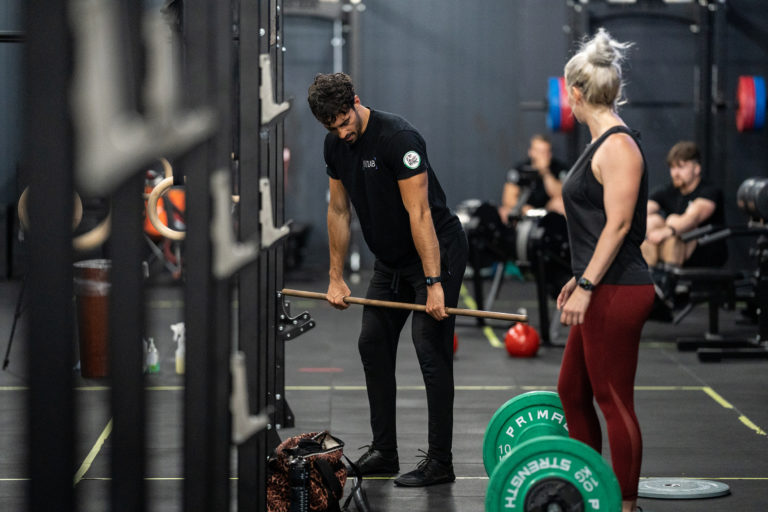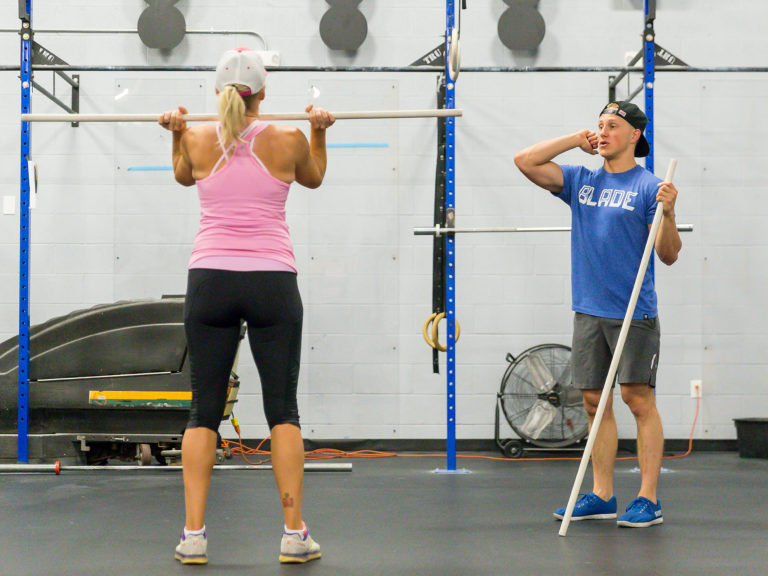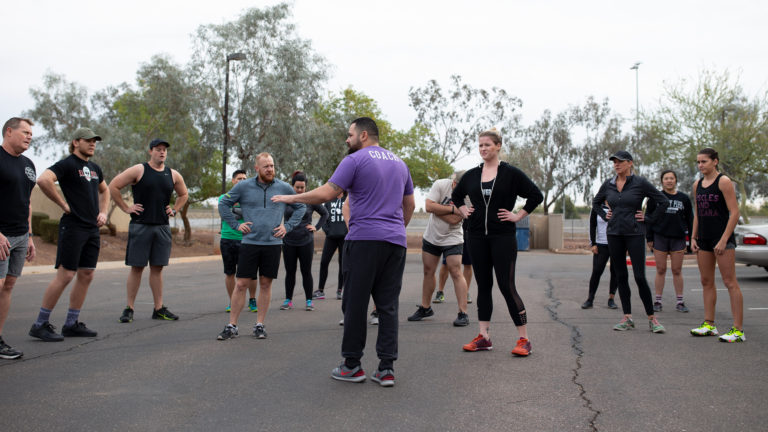Adam Neiffer didn’t start his career by coaching 2021 NOBULL CrossFit Games champion Justin Medeiros to victory. His coaching journey began in 2007 when he walked into CrossFit Portland. Neiffer said observing the coaches there showed him what was possible through CrossFit.
Imagine if the owners of CrossFit Portland had told Neiffer that, given his lack of experience, he couldn’t hang out and watch some coaching. No trainer possesses the experience needed to coach at the top level at the start of their coaching careers. Entry-level coaching expertise doesn’t qualify a coach for their future role, but over time, on-the-job experience and observation can combine to create exceptional, life-changing coaches.
You have to start somewhere when developing any skill or capacity. The idea that there is a perfect ascent in the ranks of coaching — and that athletes are untouchable until a teacher has stowed away an immense amount of book knowledge while watching from the sidelines — creates unnecessary barriers to entry. It can also weed out potential career coaches and complicates the simple — although not easy — nature of coaching movement and athletes.
How Do You Start?
So, how do you start your coaching career?
The essential first step is to do CrossFit. Being a student of CrossFit delivers an unparalleled experience with the real-life application of the material you will one day teach to others. In this setting, you learn by being an athlete. The struggles and failures associated with learning a muscle-up and the effort and time it takes to develop a double-body-weight deadlift all carry over to coaching. This is similar to many sports in which coaches take their love for the game and turn it into a lifelong profession.
Another often-overlooked starting point is the simple and accessible observation of coaches. Taking the time to observe coaches on the gym floor gives you the opportunity to witness many elements required of the profession — class timeline, scaling, interactions, presence, and attitude, to name a few. This does not have to be specific to the sport or training that you intend to coach. Watching a coach in any practice environment adds value to your development. Observing a class or practice is low risk, as you are not required to actually coach. Most coaches will not mind and are actually delighted to help an interested person pursue the profession.

In addition to watching coaches in action, it is also important to practice seeing movement, particularly if you are starting from a low level of experience with movement-based sports. Movement observation allows prospective coaches to study movement as it exists in real life. The key phrase there is “as it exists in real life.” It’s one thing to view faults in a book or in controlled demonstration environments; it’s another to observe movement patterns in a real-life setting. This type of observation can be done in a class or practice environment by watching a coach and trying to garner the nuance of how they correct and change movement patterns. Reviewing videos of recorded movement in slow motion and watching movement tutorials are additional ways to practice seeing movement.
Earning a Credential
The next step to starting a coaching career is to earn an entry-level credential in your given sport or focus. Most every sport or skill has an entry-level coaching credential — USA Gymnastics, high-school football, USA Weightlifting, and CrossFit. In the case of CrossFit, the CrossFit Level 1 Certificate Course is the entry-level credential required to coach CrossFit. The credential covers a basic education of the theory and method and the various movements and positions that are utilized in the program. Additionally, it examines safety considerations and provides practical application of the material covered through lecture as well as opportunities for participants to practice coaching others. It is the minimum standard to grant an individual the tools needed to start their CrossFit coaching career.
The Level 1 Credential
Specific to the CrossFit Level 1 credential, there are a number of elements within the course that are unique to a beginner coaching credential and are specifically geared to getting coaches out on the gym floor.
The components of the CrossFit Level 1 Certificate Course were thoroughly contemplated, tested, evaluated, and honed over time with the sole aim of preparing individuals to start a career coaching humans in a training setting. It is the best way to introduce people to coaching CrossFit.
The course is in-person and involves a “live” element, meaning the coaching is not rehearsed. Individuals are exposed to various, real-life coaching scenarios. Each scenario is an integral part of a person’s experience and exemplifies coach and athlete interactions in real time.
The course includes on-site lectures that cover the theory, method, and movements that coaches will need to one day master. The theory and movement lectures are then reinforced through practical application. You have to get up out of your lecture chair, do the movements, get corrected, and take on the challenge of coaching others. This is not a course for someone who wants to coach from the sidelines.
The practical-application sections include performing the movements in a small-group setting, which forces you to learn by doing. The theory lectures are reinforced through the application and the experience of intensity, scaling, and progression of movements.
Additionally, the course covers safety and scope of practice, and provides a recommendation for how coaches take this initial starting point and begin coaching.
Then What?
Once you have passed the exam and earned the credential, you’re now ready to step onto the floor as a coach. How you do so requires consideration of the skills you already possess alongside a commitment to finding an entry-level environment that enables you to practice and grow.
A beginner coach must find opportunities that fit within their scope of practice and are aligned with their current ability level. It seems obvious but should be stated that passing the Level 1 exam and immediately coaching a class of 20 individuals is not the recommendation for applying the credential out of the gate. We recommend that individuals start with one-on-one and small group-training sessions.

Through the process of working one-on-one with individuals, coaches can practice and apply new skills. Over time, coaches will be able to take on greater responsibility and class sizes, but this should come with time and is not a process to rush.
Defending the Beginner
There are a number of criticisms that newly minted coaches may come across from peers, naysayers, or critics.However, this phenomenon is not specific to the CrossFit coach and exists in all coaching arenas. Knowing the criticisms so you can defend your chosen career path is important for your development within your career and the ability to trust your chosen career path.
Here are the four most common criticisms:
You need a four-year degree to start coaching.
Within the strength and conditioning arena, it is a common sentiment that individuals must possess a four-year degree and possibly become a Certified Strength and Conditioning Specialist (CSCS) in order to even begin coaching. Regardless of whether this is an academic-biased approach or a desire to drive a possibly unnecessary series of credentialing processes, the fact remains that a four-year degree doesn’t include the most essential component of coaching — actually coaching. Of the thousands of coaches out there — spanning every sport and training application from swimming to tactical readiness to Olympic weightlifting — a four-year degree is not necessary to coach.
You need to have extensive book knowledge to start coaching.
Accumulation of knowledge is the curse of starting anything. Coaches are often drawn to reading more books and watching more videos because it is safe. It keeps the coach engaged in the act of coaching without ever having to actually do it.
This misconception relies on the idea that there is a specific amount of knowledge that can be learned and gathered such that the coach will be able to successfully transition to the training floor without making errors or mistakes. You cannot eliminate the vulnerability of coaching on the gym floor, where you will inevitably make mistakes and fail and expect to become a good coach. Good coaches learn by doing and supplement the learning process by reading material that furthers their knowledge in the areas where they are currently experiencing challenges.
You won’t be skilled enough to coach “really good athletes.” Athletes won’t believe in you or trust you.
Let’s be honest: If you’re a beginner coach, you’re not going to be coaching the athletic greats — just as you don’t get assigned the quarterbacks on your first day on the job as an assistant college-football strength coach. First, you don’t have the skills and knowledge to do so. You also don’t have the rapport and street cred that would persuade an athlete of that caliber to work with you. Beginner coaches naturally and appropriately migrate to working with athletes of a level where they can contribute to their improvement.
This can look like coaching a one-on-one session to a beginner with a PVC pipe. It can look like co-coaching a group class with a senior-level coach and migrating to helping those who can benefit from your skill level.
Along those same lines is the thought that athletes won’t believe in or trust you. This is largely the product of a coach who tries to coach at a level — whether it be the size of a class or the level of the athletes — that is beyond their abilities.

The Time is Now
The readiness to coach is not binary. There is not a set moment in time when the accumulation of one more piece of knowledge grants someone the ability to skip over the beginner phases of becoming a coach.
Don’t let perfection be the enemy of good, preventing you from taking action. For the onlooker, there is no perfect time to start. For the committed professional who is willing to endure failure alongside success as they climb the ranks to becoming an accomplished and well-respected coach — the time is now.
About the Author
Nicole Christensen is the owner of CrossFit Roots in Boulder, Colorado, a Certified CrossFit Coach (CF-L4), CrossFit Seminar Staff Flowmaster, and Senior Content Developer at CrossFit. She is the Managing Editor of the Professional Coach publication and enjoys coaching athletes in group classes at her affiliate.
Start Where You Are